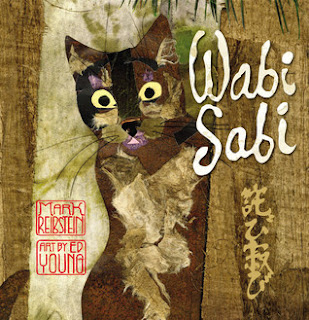Wabi
Sabi by Mark Reibstein, art by Ed Young (2008), is a story about a cat
named Wabi Sabi who lives in Kyoto, Japan.
Within the story, Wabi Sabi begins to wonder what her name means, and
sets out determined to discover its meaning.
After receiving similar answers
from her master, a cat, and a dog that her name was too difficult to explain,
she sought out a monkey at Mount Hiei. Wabi
sabi is a way that one may see the world; this concept began from the ways of
the Ancient Chinese, and began to sculpt Japanese culture (Reibstein, 2008). Basically, wabi sabi is a way or a feeling in
which one can see harmony and beauty within simplicity. This concept also incorporates humility, and
its importance in the world.
Wabi
Sabi can be classified as a multicultural children’s picturebook that incorporates
fiction, a nonfiction concept, as well as poetry. This book includes a cat’s story and haiku
poems that can be found in both Japanese and English (Reibstein, 2008; Galda,
Cullinan, & Sipe, 2010). Within the
story, Wabi Sabi appears to be a dimensional character who begins as simple and
confident, and quick transitions to unsure and insecure. After her journey to discover her name’s
meaning, she becomes quite content again.
This story takes place in Kyoto, Japan, and in a world that is both
realistic, and somewhat fanciful, as the animals are able to talk to one
another. Reibstein does a tremendous job of developing the character of Wabi Sabi, as well as the events that take place during her search; in a sense, it is as if Wabi Sabi was at conflict with herself, as she was unaware of her own name's meaning, and therefore herself. Wabi Sabi also incorporates nonfiction, as wabi sabi is a real
concept or feeling that is used in Japanese culture. Lastly, Reibstein writes not only a narrative,
but also haikus, which are short, Japanese poems. Haiku poetry works to express details one can
envision through the senses, and is usually inspired by nature; these poems are
written in 3 lines, with 5, 7, and 5 syllables.
Ed Young is the illustrator of Wabi Sabi.
Within Wabi Sabi, Young
uses the technique of collage to create illustrations that appear to be
multilayered and filled with vibrant details and color (Galda et al.,
2010). Young’s collages incorporate many
objects to create an image that is both realistic, natural, and fictional. Objects such as a straw mat, pine needles,
hair/fur, and leaves create a dimensional look to each page. Young also uses water colors, photography,
and many other medium types within his illustrations. Also, instead of the book opening and turning
pages horizontally, the book opens and turns vertically. I have another blog posting with
illustrations by Ed Young, so if curious, check out Lon Po Po!
"Wabi Sabi:" An illustration by Ed Young within the children's picturebook.
I really enjoyed reading Wabi Sabi, as it took a concept that was
difficult to understand, wabi sabi, and broke it down into a children’s
story. I found the narrative to be
especially useful to understanding the concept, and the haiku complemented the
story beautifully; however, such poetry may be difficult for young readers to
understand. The back of the story does
include several translations for several haiku phrases in both Japanese and
English. This is also a story that
allows my son to stare at the pictures for several minutes before turning the
page.
The author, Mark Reibstein is both a
writer and an English teacher. Throughout
his life, Reibstein lived in many different places, including Kyoto, Japan;
while there, Reibstein had a cat named Wabi Sabi. Wabi
Sabi was the first picturebook that Reibstein wrote (Powell’s Books,
2013).
"Mark Reibstein:" Author of Wabi Sabi
Below are 2 motivational activities
and reader response questions that would be beneficial for students within the
classroom: (3rd/4th
grade Activites)
- The first
activity would incorporate art and poetry for the students. After reading Wabi Sabi, students would be able to create a collage of
something that represented beauty to him or her within nature/the world. Students would be encouraged to use
watercolors, realistic objects, outlining, and any other media or
techniques that would bring the picture to life. After the collages were finished,
students would begin writing a haiku about the beauty within the
collage. (Remember, haikus are
poems with 3 lines; the 1st has 5 syllables, the 2nd
7, and the 3rd has 5 syllables.
Haikus also use one’s senses and objects of nature.) As in the concept of wabi sabi, the
collage may appear simple, but holds great beauty!
- The 2nd
activity would allow students to look up one’s own name and its
meaning. Each student would be
given the opportunity to search for the meaning of one’s name on the
computer. Students would also be
able to ask one’s parents why this name was chosen for him or her. After all of the information was
gathered, students would create a small poster with his or her name, including
pictures and text describing the meaning.
Reader
Response Questions:
- What was
the author trying to tell you through this book?
- Have you ever seen something that others thought
was simple and imperfect, but you thought it was beautiful? Explain!
- Why do you think Wabi Sabi’s friends had such a
difficult time explaining the meaning of her name?
References
Galda,
L., Cullinan, B.E., & Sipe, L. R. (2010).
Literature and the Child (7th ed.). Belmont, CA:
Wadsworth, Inc.
Powell’s
Books. (2013). “Mark Reibstein”. [online image]. Retrieved from
http://www.powells.com/kidsqa/markreibstein.html
Powell’s
Books. (2013). Kids’ Q&A: Mark Reibstein. Retrieved from
http://www.powells.com/kidsqa/markreibstein.html
Reibstein,
M. (2008). Wabi
Sabi. New York, NY: Little, Brown and Company.
Young,
E. (1989). Lon Po Po: A Red-Riding
Hood story from China. New York, NY: Penguin
Putnam Books
Young,
E. (2011). “Wabi Sabi”.
[online image]. Retrieved from
exhibit-spans/
Young,
E. (2013). “Wabi Sabi”.
[online image]. Retrieved from
http://www.goodreads.com/book/show/1464412.Wabi_Sabi













